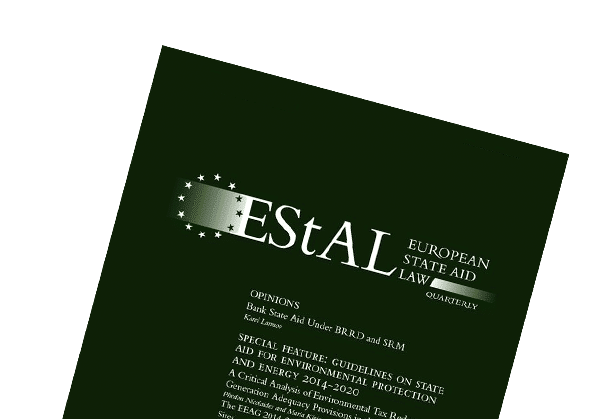
Introduction
State guarantees may constitute State aid if they are not priced at market rates. A properly priced guarantee reflects the risk assumed by the public authority that issues it and the collateral, if any, that the beneficiary undertaking can pledge.
The State aid that is embedded in a guarantee that is priced below the relevant market rate is operating aid. In most cases, a state guarantee merely enables the beneficiary undertaking to borrow more cheaply. The loan may be used to carry out an investment project or simply to cover day-to-day expenses. Therefore, if the aid in such a guarantee is to be compatible with the internal market it must be linked to another public measure that complies with the provisions of the GBER or is notified to the Commission for prior authorisation. Otherwise, the guarantee must be designed to comply with the requirements of the de minimis regulation [Regulation 1407/2013].
The 2008 Commission Notice on State aid in state guarantees defines safe-harbour rates for individual guarantees to SMEs. If a Member State wants to develop a guarantee scheme or to grant guarantees to large enterprises as well, it must also notify its methodology to the Commission.
Background
In mid-April 2022, Greece submitted to the European Commission a methodology for the calculation of guarantee premiums. The Commission approved it in mid-June 2022 in decision SA.102741.[1] However, the approval within two months belies the complexity of the methodology. It was initially pre-notified 18 months earlier in September 2020. In addition, in the period between September 2020 and April 2022, Commission officials had several meetings with the Greek authorities.
What sets the Greek methodology apart is that it is designed to apply to guarantees that cover loans to large companies. Normally, the methodologies that are individually notified by Member States are used to determine the gross grant equivalent [GGE] of State aid in guarantees provided to SMEs. Indeed, the Greek methodology had to be notified to the Commission because it could not rely on the 2008 Commission Notice on guarantees that sets safe-harbour rates for individual guarantees to SMEs.
Nonetheless, in common with other notified methodologies, the Greek measure serves two purposes: to determine the existence of State aid and to calculate the amount of State aid, if any, that may be granted through premiums below market rates on the basis of the de minimis Regulation [Regulation 1407/2013] or the General Block Exemption Regulation [GBER] [Regulation 651/2014].
The Greek methodology will be used for valuation of both individual guarantees and guarantees granted in the context of schemes. The guarantee coverage will not exceed 80% of the outstanding principal of the loans.
Undertakings in difficulty and guarantees for financial institutions are excluded from the scope of the measure.
The basic assumptions for guarantees to be free of State aid
The proposed approach establishes the credit risk of the borrower which is expressed as the one-year probability of default. This probability is given by the credit-rating system of the ICAP Group which is a European credit-rating agency and the collateral that may be pledged by the borrower.
A table in the Commission decision shows the correspondence between the risk classification of ICAP and the rating classes of Standard & Poor’s, Fitch and Moody’s. There are ten ICAP classes that vary from a top of AA with 0.05% probability of default to a bottom of H with probability of default exceeding 29%.
The individual components of the market premium
The derived market premium, which in the decision is labelled “base guarantee premium” or “total commission fee”, is made up of three components reflecting the following costs:
- Normal risk costs: The assumed risk is based on the credit rating of the borrower, which in turn is based on historic data on the default rates of companies in each rating class. The default rates serve as a floor which, for prudency, are adjusted upwards.
- Administration and other operational costs: The administration costs are set at a fixed rate of 0.25% per annum.
- Remuneration of capital: A fee of 0.38% per annum is charged for the rating categories (AA-C) and a fee of 0.57% per annum for the lower rating categories (D-H).
The remuneration of capital above is calculated as follows: A notional 9.5% capital for the AA-C rating categories remunerated at 4.00% gives 0.38%. A notional 9.5% capital for the D-H rating categories remunerated at 6.00% gives 0.57%. It should be noted that the 2008 Guarantee Notice requires capital of 8% to be remunerated at 4%, which gives 0.32%. That is, the Greek measure was more conservative.
The derived market premium is
P = (Z*D)*(R + A + C), where
- P: derived market premium.
- Z: percentage of the loan principal covered by the guarantee.
- D: amount of loan principal.
- A: administrative cost.
- C: cost of capital.
There are two safeguards applied to the derived premium: A floor is established by the so-called Itraxx Europe rate and by the credit default swaps [CDS] if they exist for the borrower.
Furthermore, the risk margin is adjusted depending on the coverage of the collateral that may be offered by the borrower. For example, for a borrower that is rated BB, the basic probability of default is 0.27%. If the borrower offers no collateral, the probability is raised to 0.48%. If it offers collateral up to 30% of the guaranteed amount, the probability is raised to 0.45% and if the collateral exceeds 30% of the guaranteed amount, the probability is set at 0.36%.
The value of the collateral will be estimated by independent experts at the forced sale value. The bank that will obtain the collateral will have first rank in case of foreclosure. However, in case of default, the revenue from any forced sale of assets pledged as collateral will be shared pari passu between the guarantor – i.e. the state – and the lending institution.
On the basis of the above inputs, the derived market premium varies from 0.70% to 27.46%.
Avoidance of State aid to lending institutions
In order to prevent lending institutions from deriving an undue advantage by charging higher rates of interest, the Greek measure includes a formula by which the derived market premium is compared to the implied CDS of the borrower. The formula for the hypothetical CDS is the following:
CDS (borrower) = [(I – A – G*CDS (Greece))/(1 – G)], where
- I: effective interest rate charged by the financial institution
- A: 0.75% which is the administrative costs of Greek commercial banks
- G: guaranteed amount [normally 80% of the outstanding principal of the loan]
- CDS(Greece): the current five-year sovereign CDS of Greece [1.28% at the time of the notification]
If the implied CDS rate is higher than the total guarantee premium, then the lending bank will be requested to lower its effective interest rate R. Otherwise, the guarantee premium will be increased accordingly.
The GGE of State aid in guarantees
The same methodology will be used to calculate the GGE of State aid embedded in guarantees that are priced below market rates.
The GGE is the difference between derived market premium and the premium that will actually be paid by the borrower. For multi-year guarantees, the annual GGE will be discounted to their present value using the applicable discount rate [i.e. the base rate, as periodically defined by the Commission for each Member State, plus 1%].
For one-year guarantees, the GGE is as follows
GGE = D*Z*(P – p), where
- D: amount of the outstanding loan.
- Z: the percentage of outstanding loan D covered by the guarantee.
- P = theoretical market premium of the guarantee.
- p: premium that is actually paid by the beneficiary for admission to the guarantee scheme.
For multi-year loans and guarantees where the borrower pays and annual premium, the GGE is as follows
GGE = ∑D*Z*(P – p)/(1 + r)t, where
- r: rate of discount [base rate + 1%].
- t: number of years.
If the borrower pays a single premium at the moment the multi-year guarantee is granted, the GGE is as follows
GGE = ∑D*Z*P/(1 + r)t – p
Commission assessment
The Commission assessed the notified measure “(46) against the requirements of the Guarantee Notice, specifically the requirements in sections 3.2 (for individual guarantees), 3.4 (for guarantee schemes), 4.1 and 4.2 (for individual guarantees containing an aid element), 4.4 (for guarantee schemes containing an aid element), 5 (on compatibility conditions of State aid) and 6 (with respect to reporting requirements).”
Assessment of premiums for individual guarantees
“(51) In the absence of an observable market price, the guarantee premium will cover an administrative cost, a remuneration for capital which is dependent on the credit quality of the borrower and a remuneration for expected losses, which is dependent on the level of collateral.”
The Commission noted favourably that:
- Undertakings in difficult are excluded.
- The guarantees:
- will be granted for a fixed maximum amount
- on a specific financial instrument
- their extent of the guarantees can be properly measured
- will be linked to a specific financial transaction
- will be limited in time
- will not cover more than 80% of the outstanding loan amount
- Losses will be sustained by the state as guarantor and the lender in the same ratio.
- Any revenue from sale of assets will also be shared proportionately.
The Commission also noted positively that, in case the borrower has a quoted CDS price, that market reference price will be used.
Assessment of premiums for guarantee schemes
The Commission repeated its earlier findings concerning the basic features of the Greek measure [e.g. exclusion of undertakings in difficulty, coverage of less than 80% of the loan principal, etc] which were also relevant for schemes.
However, “(71) specifically for guarantee schemes, the Commission needs to assess a number of additional conditions.”
The Greek measure was confirmed to comply with the following additional conditions:
- The derived market premium covers the expected losses for each of the rating categories under conservative assumptions.
- The administrative cost fee of 0.25% per annum is reasonable, in light of the targeting of larger undertakings for larger loan amounts.
- The remuneration of capital is higher than the required rate by the 2008 Notice.
- The methodology foresees a floor linked to Credit Default Swap Index prices of appropriate maturity and a governance mechanism linking the risk perceived by the financial intermediary, reflected by the interest rate it charges on the loan, to the total guarantee premium.
“(75) The Commission therefore concludes that guarantee schemes under this methodology will be, in all probability, self-financing, and will also exclude, to the extent possible, aid at the level of the financial intermediary, in line with sections 2.3 and 3.4 (d) of the Guarantee Notice.”
“(76) The methodology also complies with the other requirement of that same section 3.4 (d) regarding the need to assess each new guarantee on the basis of all relevant factors, including the credit quality of the borrower (by virtue of its ICAP rating), the level of securities (with three different coverage ratio levels) and the duration of the guarantee (with three different maturity buckets on the CDS Index floor).”
Assessment of guarantees with an aid element
“(80) Where an individual guarantee or a guarantee scheme is not provided on market terms, in particular when the State guarantee is not properly remunerated, it may entail State aid. In such case, the aid element can be calculated by using the notified methodology and it will amount in principle to the difference between the appropriate market price of the guarantee (as calculated based on the notified methodology) and the actual guarantee premium paid. The resulting cash grant equivalents should then be discounted to their present value in line with the reference rate communication”.
“(84) The Commission therefore concludes that the application of the methodology to quantify the aid element in public guarantees is in line with section 4 of the Guarantee Notice.”
In conclusion, the Commission found the Greek measure to conform with the 2008 Guarantee Notice and pointed out that “(85) Greece has committed to ensure that any aid granted will be compatible with State aid rules.”
[1] The full text of the Commission Decision can be accessed at:
SA.102741 – EL – Guarantees to Large Undertakings – Draft Decision Pre-ISC.docx (europa.eu)


